Abstract
OBJECTIVES. This paper presents a prospective examination of sociodemographic, psychosocial, and physiologic characteristics associated with positive change in cardiovascular disease risk factors during a 6-year multiple risk factor intervention study. METHODS. Data are presented on 221 women and 190 men (aged 25 through 74 years) who participated in four cohort surveys (1979 through 1985). A signal detection model was used to identify baseline variables that best divide the sample into subgroups on the basis of the probability of positive change in a composite risk factor score. RESULTS. Sixty-nine percent of the respondents showed a positive change in risk factor score during the intervention. The subgroup with the highest proportion of positive changers (83%) was composed of older adults (> 55 years) with the highest perceived risk, highest health media use, and highest blood pressure and cholesterol levels. The subgroup with the lowest proportion of positive changers (42%) was the least educated, was the most likely to be Hispanic, and had the lowest health knowledge and self-efficacy scores. CONCLUSIONS. The differing composition of subgroups who respond or do not respond to community cardiovascular disease interventions illustrates the need to develop specific interventions that target different age, socioeconomic, and cultural subgroups.
Full text
PDF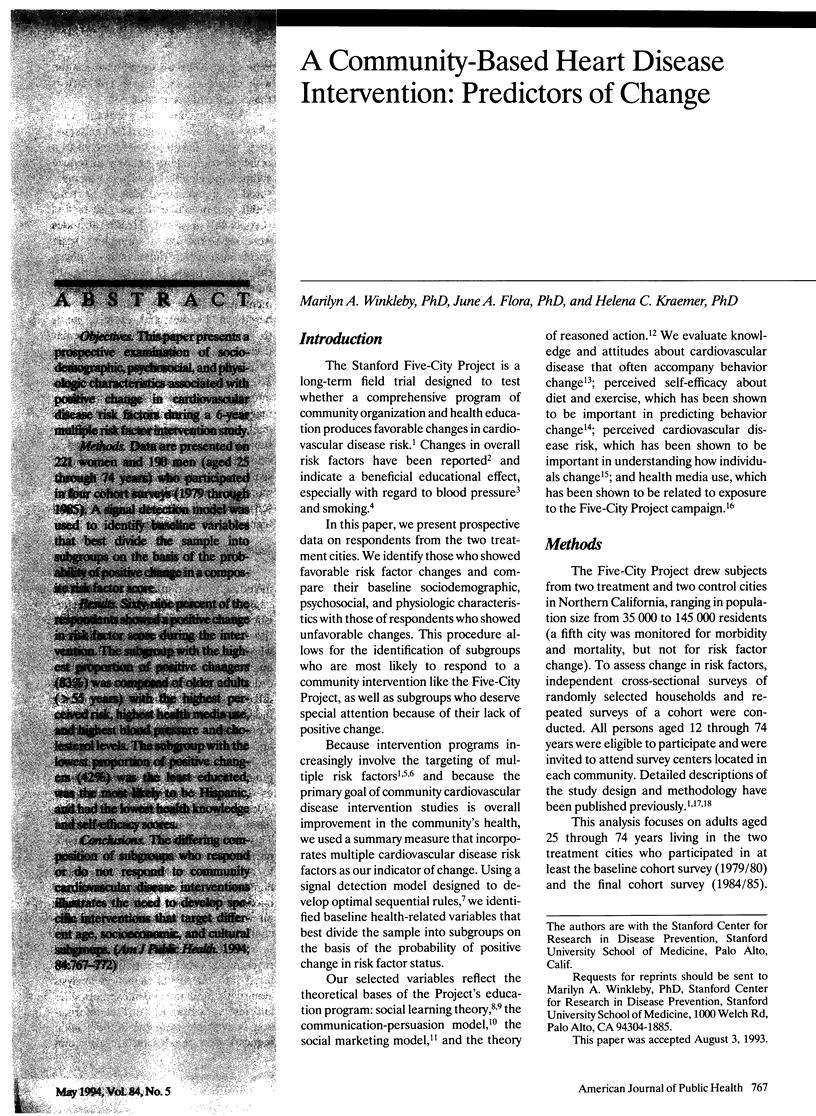
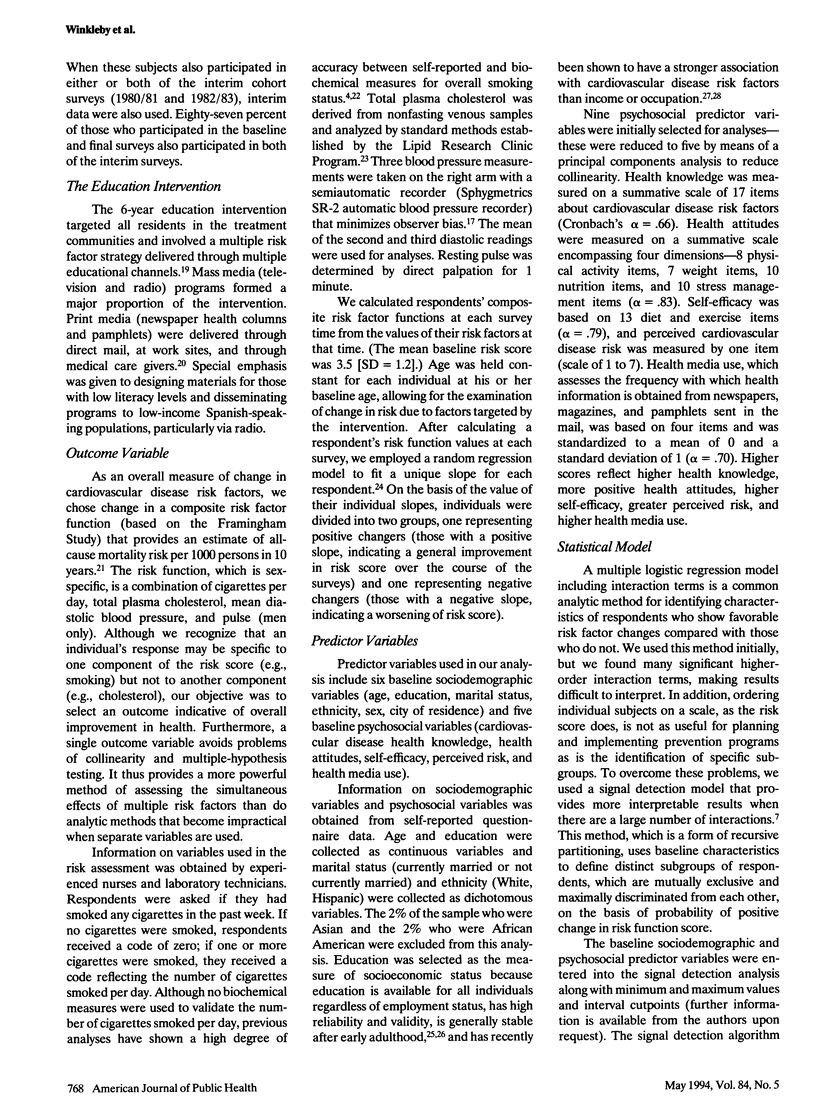
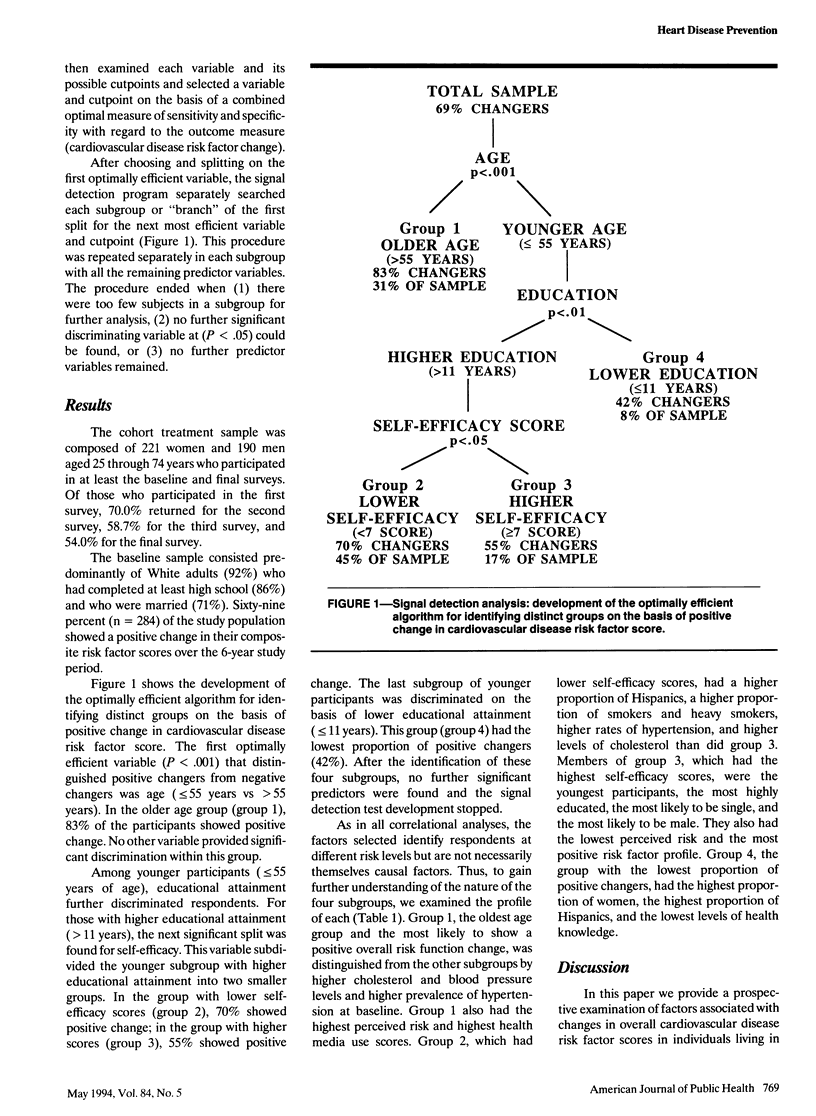
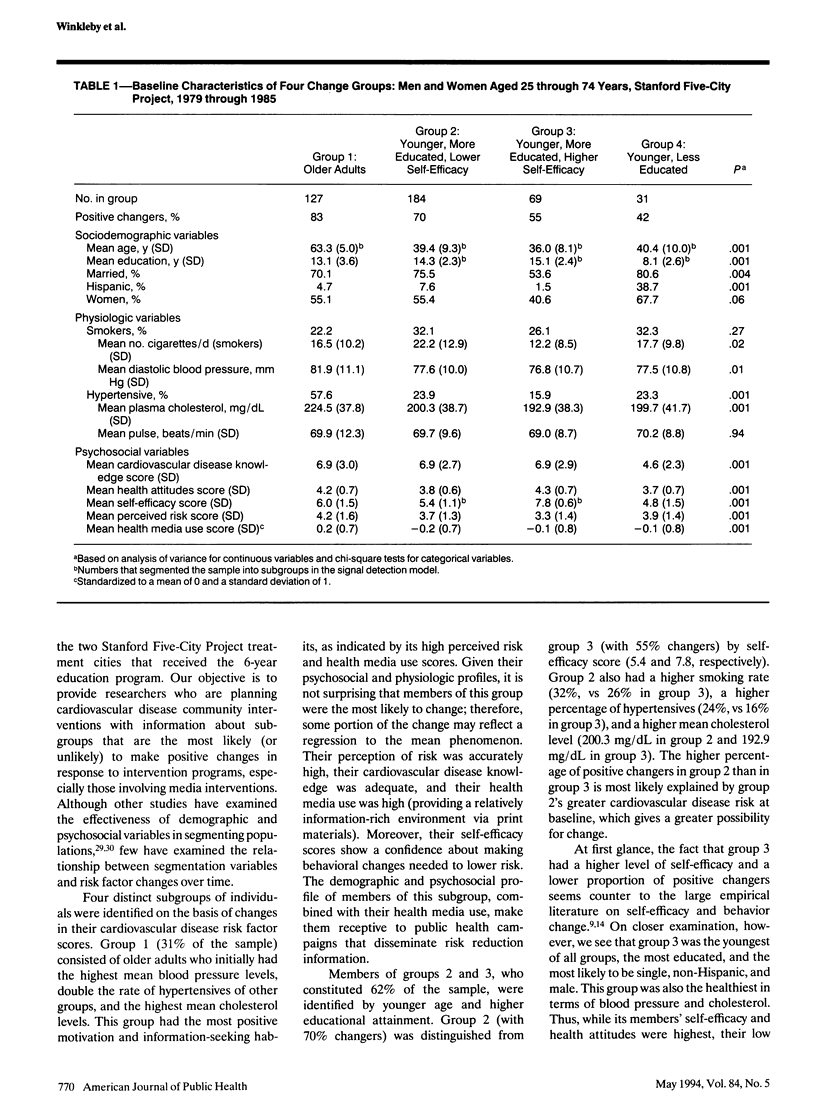

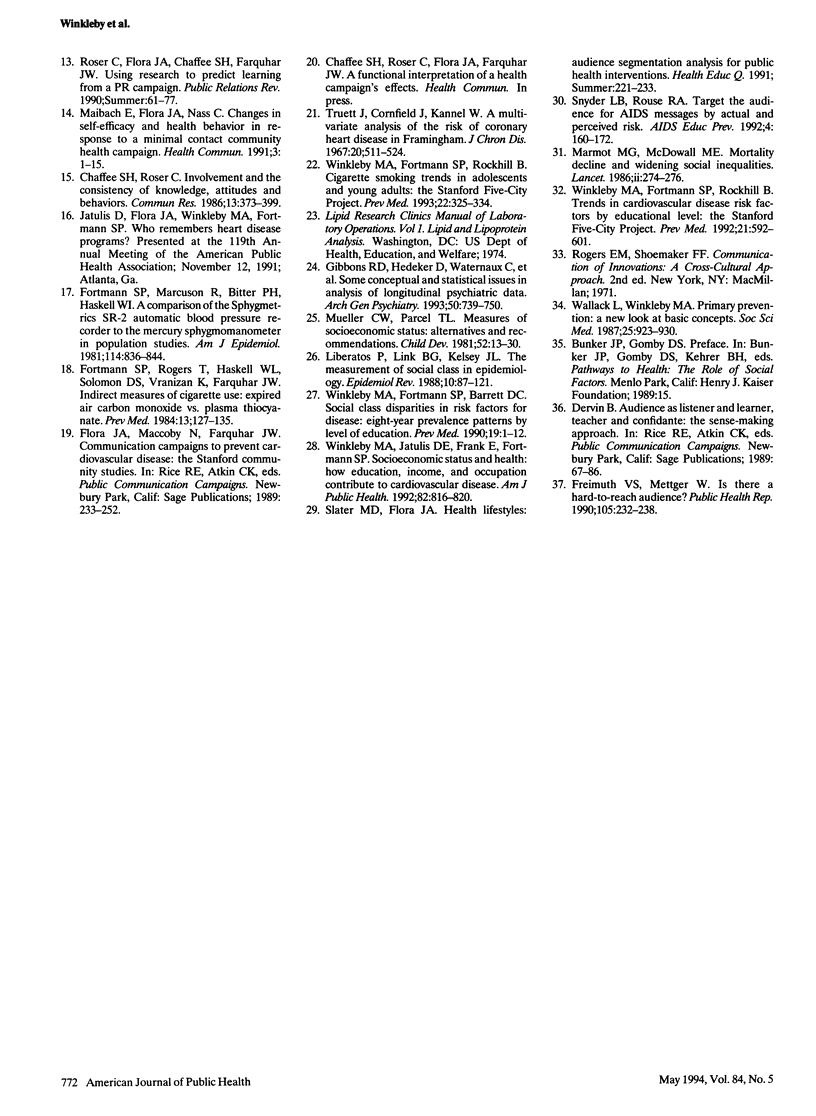
Selected References
These references are in PubMed. This may not be the complete list of references from this article.
- Carleton R. A., Lasater T. M., Assaf A., Lefebvre R. C., McKinlay S. M. The Pawtucket Heart Health Program: I. An experiment in population-based disease prevention. R I Med J. 1987 Dec;70(12):533–538. [PubMed] [Google Scholar]
- Farquhar J. W., Fortmann S. P., Flora J. A., Taylor C. B., Haskell W. L., Williams P. T., Maccoby N., Wood P. D. Effects of communitywide education on cardiovascular disease risk factors. The Stanford Five-City Project. JAMA. 1990 Jul 18;264(3):359–365. [PubMed] [Google Scholar]
- Farquhar J. W., Fortmann S. P., Maccoby N., Haskell W. L., Williams P. T., Flora J. A., Taylor C. B., Brown B. W., Jr, Solomon D. S., Hulley S. B. The Stanford Five-City Project: design and methods. Am J Epidemiol. 1985 Aug;122(2):323–334. doi: 10.1093/oxfordjournals.aje.a114104. [DOI] [PubMed] [Google Scholar]
- Fortmann S. P., Marcuson R., Bitter P. H., Haskell W. L. A comparison of the Sphygmetrics SR-2 Automatic Blood Pressure Recorder to the mercury sphygmomanometer in population studies. Am J Epidemiol. 1981 Dec;114(6):836–844. doi: 10.1093/oxfordjournals.aje.a113254. [DOI] [PubMed] [Google Scholar]
- Fortmann S. P., Rogers T., Vranizan K., Haskell W. L., Solomon D. S., Farquhar J. W. Indirect measures of cigarette use: expired-air carbon monoxide versus plasma thiocyanate. Prev Med. 1984 Jan;13(1):127–135. doi: 10.1016/0091-7435(84)90045-8. [DOI] [PubMed] [Google Scholar]
- Fortmann S. P., Taylor C. B., Flora J. A., Jatulis D. E. Changes in adult cigarette smoking prevalence after 5 years of community health education: the Stanford Five-City Project. Am J Epidemiol. 1993 Jan 1;137(1):82–96. doi: 10.1093/oxfordjournals.aje.a116605. [DOI] [PubMed] [Google Scholar]
- Fortmann S. P., Winkleby M. A., Flora J. A., Haskell W. L., Taylor C. B. Effect of long-term community health education on blood pressure and hypertension control. The Stanford Five-City Project. Am J Epidemiol. 1990 Oct;132(4):629–646. doi: 10.1093/oxfordjournals.aje.a115705. [DOI] [PubMed] [Google Scholar]
- Freimuth V. S., Mettger W. Is there a hard-to-reach audience? Public Health Rep. 1990 May-Jun;105(3):232–238. [PMC free article] [PubMed] [Google Scholar]
- Gibbons R. D., Hedeker D., Elkin I., Waternaux C., Kraemer H. C., Greenhouse J. B., Shea M. T., Imber S. D., Sotsky S. M., Watkins J. T. Some conceptual and statistical issues in analysis of longitudinal psychiatric data. Application to the NIMH treatment of Depression Collaborative Research Program dataset. Arch Gen Psychiatry. 1993 Sep;50(9):739–750. doi: 10.1001/archpsyc.1993.01820210073009. [DOI] [PubMed] [Google Scholar]
- Lefebvre R. C., Flora J. A. Social marketing and public health intervention. Health Educ Q. 1988 Fall;15(3):299–315. doi: 10.1177/109019818801500305. [DOI] [PubMed] [Google Scholar]
- Liberatos P., Link B. G., Kelsey J. L. The measurement of social class in epidemiology. Epidemiol Rev. 1988;10:87–121. doi: 10.1093/oxfordjournals.epirev.a036030. [DOI] [PubMed] [Google Scholar]
- Marmot M. G., McDowall M. E. Mortality decline and widening social inequalities. Lancet. 1986 Aug 2;2(8501):274–276. doi: 10.1016/s0140-6736(86)92085-4. [DOI] [PubMed] [Google Scholar]
- Scollay P. A., Doucett M., Perry M., Winterbottom B. AIDS education of college students: the effect of an HIV-positive lecturer. AIDS Educ Prev. 1992 Summer;4(2):160–171. [PubMed] [Google Scholar]
- Slater M. D., Flora J. A. Health lifestyles: audience segmentation analysis for public health interventions. Health Educ Q. 1991 Summer;18(2):221–233. doi: 10.1177/109019819101800207. [DOI] [PubMed] [Google Scholar]
- Truett J., Cornfield J., Kannel W. A multivariate analysis of the risk of coronary heart disease in Framingham. J Chronic Dis. 1967 Jul;20(7):511–524. doi: 10.1016/0021-9681(67)90082-3. [DOI] [PubMed] [Google Scholar]
- Wallack L., Winkleby M. Primary prevention: a new look at basic concepts. Soc Sci Med. 1987;25(8):923–930. doi: 10.1016/0277-9536(87)90263-2. [DOI] [PubMed] [Google Scholar]
- Winkleby M. A., Fortmanm S. P., Rockhill B. Cigarette smoking trends in adolescents and young adults: the Stanford Five-City Project. Prev Med. 1993 May;22(3):325–334. doi: 10.1006/pmed.1993.1027. [DOI] [PubMed] [Google Scholar]
- Winkleby M. A., Fortmann S. P., Barrett D. C. Social class disparities in risk factors for disease: eight-year prevalence patterns by level of education. Prev Med. 1990 Jan;19(1):1–12. doi: 10.1016/0091-7435(90)90001-z. [DOI] [PubMed] [Google Scholar]
- Winkleby M. A., Fortmann S. P., Rockhill B. Trends in cardiovascular disease risk factors by educational level: the Stanford Five-City Project. Prev Med. 1992 Sep;21(5):592–601. doi: 10.1016/0091-7435(92)90067-r. [DOI] [PubMed] [Google Scholar]
- Winkleby M. A., Jatulis D. E., Frank E., Fortmann S. P. Socioeconomic status and health: how education, income, and occupation contribute to risk factors for cardiovascular disease. Am J Public Health. 1992 Jun;82(6):816–820. doi: 10.2105/ajph.82.6.816. [DOI] [PMC free article] [PubMed] [Google Scholar]


